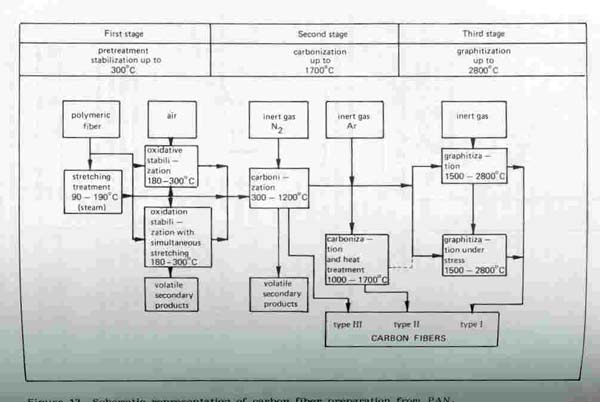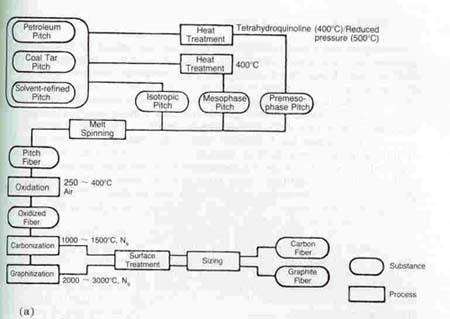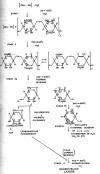CARBON Fibers (Educational Research)
Monika Kannadaguli & Haoming Rong
INTRODUCTION
Carbon Fibers are a new breed of high-strength materials. Carbon fiber has been described as a fiber containing at least 90% carbon obtained by the controlled pyrolysis of appropriate Fibers. The existence of carbon fiber came into being in 1879 when Edison took out a patent for the manufacture of carbon filaments suitable for use in electric lamps. However, it was in the early 1960s when successful commercial production was started, as the requirements of the aerospace industry - especially for military aircraft - for better and lightweight materials became of paramount importance. In recent decades, carbon Fibers have found wide application in commercial and civilian aircraft, recreational, industrial, and transportation markets. Carbon Fibers are used in composites with a lightweight matrix. Carbon fiber composites are ideally suited to applications where strength, stiffness, lower weight, and outstanding fatigue characteristics are critical requirements. They also can be used in the occasion where high temperature, chemical inertness and high damping are important. The suppliers of Advanced Composites Materials Association released 1997 industry statistics on worldwide shipments of carbon Fibers for composites[1,2] (Table 1). However, from 1997 to 1999 there was a global slowing of carbon fiber demand[3].
Table 1 Worldwide shipments of carbon Fibers for composites
| year | pounds |
| 1992 | 13,000,812 |
| 1993 | 14,598,544 |
| 1994 | 17,425,452 |
| 1995 | 19,714,671 |
| 1996 | 20,672,741 |
| 1997 | 25,900,000 |
Currently, the United States of America uses nearly 60% of the world production of carbon Fibers and the Japanese account for almost 50% of the world capacity for production. The largest producer of this fiber is Toray Industries of Japan. The world production capacity of pitch based carbon fiber is almost totally based in Japan[9].
CLASSIFICATION AND TYPES:
On the basis of modulus, strength, and final heat treatment temperature, carbon Fibers can be classified into the following categories:
Based on carbon fiber properties, carbon Fibers can be grouped into:
- Ultra-high-modulus, type UHM (modulus >450Gpa)
- High-modulus, type HM ( modulus between 350-450Gpa )
- Intermediate-modulus, type IM (modulus between 200-350Gpa)
- Low modulus and high-tensile , type HT ( modulus < 100Gpa, tensile
strength > 3.0Gpa)
- Superhigh-tensile, type SHT (tensile strength > 4.5Gpa)
Based on precursor fiber materials, carbon Fibers are classified into;
- PAN-based carbon Fibers
- Pitch-based carbon Fibers
- Mesophase pitch-based carbon Fibers
- Isotropic pitch-based carbon Fibers
- Rayon-based carbon Fibers
- Gas-phase-grown carbon Fibers
Based on final heat treatment temperature, carbon Fibers are classified into:
- Type-I, high-heat-treatment carbon Fibers (HTT), where final heat
treatment temperature should be above 2000EC
and can be associated with high-modulus type fiber.
- Type-II, intermediate-heat-treatment carbon Fibers (IHT), where final
heat treatment temperature should be around or above 1500EC
and can be associated with high-strength type fiber.
- Type-III, low-heat-treatment carbon Fibers, where final heat treatment
temperatures not greater than 1000EC. These
are basically low modulus and low strength materials.
MANUFACTURE
In Textile Terms and Definitions, carbon fiber has been described as a fiber containing at least 90% carbon obtained by the controlled pyrolysis of appropriate Fibers. The term "graphite fiber" is used to describe Fibers that have carbon in excess of 99%. A large variety of Fibers called precursors are used to produce carbon Fibers of different morphologies and different specific characteristics. The most prevalent precursors are polyacrylonitrile(PAN), cellulosic Fibers (viscose rayon, cotton), petroleum or coal tar pitch and certain phenolic Fibers.
Carbon Fibers are manufactured by the controlled pyrolysis of organic precursors in fibrous form. It is basically a heat treatment of the precursor that removes the oxygen, nitrogen and hydrogen to form carbon Fibers. It is well established in carbon fiber literature that the mechanical properties of the carbon Fibers are improved by increasing the crystallinity and orientation, and by reducing defects in the fiber. The best way to achieve this is to start with a highly oriented precursor and then maintain the initial high orientation during the process of stabilization and carbonization through tension.
Carbon Fibers from polyacrylonitrile(PAN):
There are three successive stages in the conversion of PAN precursor into high-performance carbon Fibers.
$
Oxidative stabilization: The polyacrylonitrile precursor is first stretched and simultaneously oxidised in a temperature range of 200-300EC. This treatment converts thermoplastic PAN to a non-plastic cyclic or ladder compound.
$
Carbonization: After oxidation, the Fibers are carbonized at about 1000EC without tension in an inert atmosphere (normally nitrogen) for a few hours. During this process the non-carbon elements are removed as volatiles to give carbon Fibers with a yield of about 50% of the mass of the original PAN.
$
Graphitization: Depending on the type of fiber required, the Fibers are treated at temperatures between 1500-3000EC which improves the ordering and orientation of the crystallites in the direction of the fiber axis.
Figure 1 Schematic representation of carbon fiber preparation from PAN
Fibers.

Carbon Fibers from rayon:
The conversion of rayon Fibers into carbon Fibers is a three-stage process:
$
Stabilization: Stabilization is basically an oxidative process that occurs through steps. In the first step, between 25-150EC, there is physical desorption of water. The next step is a dehydration of the cellulosic unit between 150-240EC. Finally, thermal cleavage of the cyclosidic linkage and scission of ether bonds and some C-C bonds via free radical reaction (240-400E C) and, thereafter, aromatization takes place.
$
Carbonization: Between 400 and 700EC, the carbonaceous residue is converted into a graphite-like layers.
$
Graphitization: Graphitization is carried out under strain at 700-2700EC to obtain high modulus fiber through longitudinal orientation of the planes.
Figure 2 Reactions involved in the conversion of cellulose into carbon Fibers
Carbon Fibers from pitch:
The carbon fiber fabrication from pitch generally consists of the following four steps:
$
Pitch preparation: It is an adjustment in the molecular weight, viscosity, and crystal orientation for spinning and further heating.$
Spinning and drawing: In this stage, pitch is converted into filaments, with some alignment in the crystallites to achieve the directional characteristics.$
Stabilization: In this step, some kind of thermosetting to maintain the filament shape during pyrolysis. The stabilization temperature is between 250 and 400 EC.$
Carbonization: The carbonization temperature is between 1000-1500 EC.
Figure 3
Manufacturing process schematic for pitch-based carbon Fibers

CARBON Fibers IN MELTBLOWN NONWOVENS
Carbon Fibers made from the spinning of molten pitches are of interest because of the high carbon yield from the precursors and the relatively low cost of the starting materials. Stabilization in air and carbonization in nitrogen can follow the formation of melt-blown pitch webs. Processes have been developed with isotropic pitches and with anisotropic mesophase pitches. The mesophase pitch based and melt blown discontinuous carbon Fibers have a peculiar structure. These Fibers are characterized in that a large number of small domains, each domain having an average equivalent diameter from 0.03mm to 1mm and a nearly unidirectional orientation of folded carbon layers, assemble to form a mosaic structure on the cross-section of the carbon Fibers. The folded carbon layers of each domain are oriented at an angle to the direction of the folded carbon layers of the neighboring domains on the boundary[4].
Carbon Fibers from isotropic pitch:
The isotropic pitch or pitch-like material, i.e., molten polyvinyl chloride, is melt spun at high strain rates to align the molecules parallel to the fiber axis. The thermoplastic fiber is then rapidly cooled and carefully oxidized at a low temperature (<100EC). The oxidation process is rather slow, to ensure stabilization of the fiber by cross-linking and rendering it infusible. However upon carbonization, relaxation of the molecules takes place, producing Fibers with no significant preferred orientation. This process is not industrially attractive due to the lengthy oxidation step, and only low-quality carbon Fibers with no graphitization are produced. These are used as fillers with various plastics as thermal insulation materials.
Carbon Fibers from anisotropic mesophase pitch:
High molecular weight aromatic pitches, mainly anisotropic in nature, are referred to as mesophase pitches. The pitch precursor is thermally treated above 350EC to convert it to mesophase pitch, which contains both isotropic and anisotropic phases. Due to the shear stress occurring during spinning, the mesophase molecules orient parallel to the fiber axis. After spinning, the isotropic part of the pitch is made infusible by thermosetting in air at a temperature below it's softening point. The fiber is then carbonized at temperatures up to 1000EC. The main advantage of this process is that no tension is required during the stabilization or the graphitizition, unlike the case of rayon or PAN precursors.
STRUCTURE
The characterization of carbon fiber microstructure has been mainly been performed by x-ray scattering and electron microscopy techniques. In contrast to graphite, the structure of carbon fiber lacks any three dimensional order. In PAN-based Fibers, the linear chain structure is transformed to a planar structure during oxidative stabilization and subsequent carbonization. Basal planes oriented along the fiber axis are formed during the carbonization stage. Wide angle x-ray data suggests an increase in stack height and orientation of basal planes with an increase in heat treatment temperature. A difference in structure between the sheath and the core was noticed in a fully stabilized fiber. The skin has a high axial preferred orientation and thick crystallite stacking. However, the core shows a lower preferred orientation and a lower crystallite height.
PROPERTIES
In general, it is seen that the higher the tensile strength of the precursor the higher is the tenacity of the carbon fiber. Tensile strength and modulus are significantly improved by carbonization under strain when moderate stabilization is used. X-ray and electron diffraction studies have shown that in high modulus type Fibers, the crystallites are arranged around the longitudinal axis of the fiber with layer planes highly oriented parallel to the axis. On the whole, the strength of a carbon fiber depends on the type of precursor, the processing conditions, heat treatment temperature and the presence of flaws and defects. With PAN based carbon Fibers, the strength increases up to a maximum of 1300oC and then gradually decreases. The modulus has been shown to increase with increasing temperature.
PAN based Fibers typically buckle on compression and form kink bands at the innermost surface of the fiber. However, similar high modulus type pitch-based Fibers deform by a shear mechanism with kink bands formed at 45E to the fiber axis.
Carbon Fibers are very brittle. The layers in the Fibers are formed by strong covalent bonds. The sheet-like aggregations allow easy crack propagation. On bending, the fiber fails at very low strain.
APPLICATIONS
The two main applications of carbon Fibers are in specialized technology, which includes aerospace and nuclear engineering, and in general engineering and transportation, which includes engineering components such as bearings, gears, cams, fan blades and automobile bodies. Recently, some new applications of carbon Fibers have been found. Such as rehabilitation of a bridge[5] in building and construction industry. Others include: decoration in automotive, marine, general aviation interiors, general entertainment and musical instruments and after-market transportation products[6]. Conductivity in electronics technology[7] provides additional new application. Table 2 illustrates some of the characteristics and applications of carbon Fibers[8].
Table 2 Characteristics and Applications of Carbon Fibers
|
Table 2. Characteristics and Applications of Carbon Fibers |
|
| 1. Physical strength, specific toughness, light weight | Aerospace, road and marine transport, sporting goods |
| 2. High dimensional stability, low coefficient of thermal expansion, and low abrasion | Missiles, aircraft brakes, aerospace antenna and support structure, large telescopes, optical benches, waveguides for stable high-frequency (Ghz) precision measurement frames |
| 3. Good vibration damping, strength, and toughness | Audio equipment, loudspeakers for Hi-fi equipment, pickup arms, robot arms |
| 4. Electrical conductivity | Automobile hoods, novel tooling, casings and bases for electronic equipments, EMI and RF shielding, brushes |
| 5. Biological inertness and x-ray permeability | Medical applications in prostheses, surgery and x-ray equipment, implants, tendon/ligament repair |
| 6. Fatigue resistance, self-lubrication, high damping | Textile machinary, genera engineering |
| 7. Chemical inertness, high corrosion resistance | Chemical industry; nuclear field; valves, seals, and pump components in process plants |
| 8. Electromagnetic properties | Large generator retaining rings, radiological equipment |
The production of highly effective fibrous carbon adsorbents with low diameter, excluding or minimizing external and intra-diffusional resistance to mass transfer, and therefore, exhibiting high sorption rates is a challenging task. These carbon adsorbents can be converted into a wide variety of textile forms and nonwoven materials [8].
Cheaper and newer versions of carbon Fibers are being produced from new raw materials. Newer applications are also being developed for protective clothing(used in various chemical industries for work in extremely hostile environments), electromagnetic shielding and various other novel applications. The use of carbon Fibers in nonwovens is in a new possible application for high temperature fire-retardant insulation (eg: furnace material.)
REFERENCES
- SACMA Releases Carbon fiber Industry Statistics, Composites News,
No. 1, 1998
- SAMPE Plenary Describes Carbon fiber Capacity, Trends, Composites
News, No. 6, 1998
- Carbon Fibers Seen as Having Big Long Term Growth Infrastructure is
Next Big Trend Driver, Advanced Materials & Composites News, No. 3, 1999
- US5536486, Carbon Fibers and Nonwoven fabrics
- Rehabilitation Bridges: Carbon fiber-reinforced Polymer Shows
Promise for Repairing Structures, Advanced Materials & Composites News,
No. 2, 1999
- New Company Launches Carbon fiber fabrics for Decorative
Applications, Advanced Materials & Composites News, No. 8, 1998
- Carbon Fibers Electrical Conductivity Found to Offer New Uses,
Composites News, No. 3, 1998
- Jean-Baptiste Donnet, Roop Chand Bansal, Carbon Fibers, publicated
by Marcel Dekker Inc., 1990, p370
- Composites Edge; 1992.
Apparel Search
Add Your Company Contact
Us About Us Advertise
News Letter Legal
Help
Copyright © 1999-2023 Apparel Search Company. All Rights Reserved.
Buy Fashion
For The Holidays.
